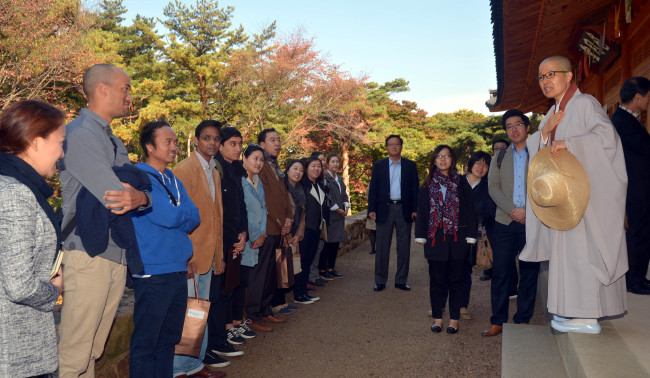If you want to experience a Templestay program in Seoul, but do not have the time to venture far, there are four popular places to do so in the area ― Myogaksa Temple and Geumseonsa Temple in Jongno-gu, Bongeunsa Temple in Gangnam-gu and the International Seon Center in Yangcheon-gu.
But not included in this list is one of the oldest temples in Seoul, Jingwansa Temple, a smaller but historically rich temple located just to the west of Seoul with a reputation for stellar temple food.
The Seoul City government is now trying to raise awareness of its historical value and its importance of being one of the four “great temples” in the city, together with Bulamsa Temple in the east, Sammaksa Temple in the south and Seunggasa Temple in the north.
To this end, they invited a dozen journalists to experience a short program Thursday.
Nestled in the expansive mountain and deep valley, the temple is not only in the foothills of the beautiful Bukhansan National Park, but also contains an impressive collection of cultural and historical properties. It provides a quiet place for city dwellers to enjoy, even as they learn about Buddhism.
As noted by Seonwoo, director of Jingwansa Templestay program, during the Joseon Dynasty, King Sejong built a library in the area for Confucian scholars to visit and read.
But not included in this list is one of the oldest temples in Seoul, Jingwansa Temple, a smaller but historically rich temple located just to the west of Seoul with a reputation for stellar temple food.
The Seoul City government is now trying to raise awareness of its historical value and its importance of being one of the four “great temples” in the city, together with Bulamsa Temple in the east, Sammaksa Temple in the south and Seunggasa Temple in the north.
To this end, they invited a dozen journalists to experience a short program Thursday.
Nestled in the expansive mountain and deep valley, the temple is not only in the foothills of the beautiful Bukhansan National Park, but also contains an impressive collection of cultural and historical properties. It provides a quiet place for city dwellers to enjoy, even as they learn about Buddhism.
As noted by Seonwoo, director of Jingwansa Templestay program, during the Joseon Dynasty, King Sejong built a library in the area for Confucian scholars to visit and read.

“The temple was built for a monk named Jingwan by the eighth king of the Goryeo dynasty, Hyeonjong, about 1,000 years ago. At the age of 12, Hyeonjong was kicked out of the palace during a power struggle. The monk Jingwan took care of him, saving his life. After Hyeonjong became king, he built a temple named after the monk called Jingwansa to repay him for his kindness.”
The temple compound consists of the main Buddha sanctuary, or “daeungjeon,” in the middle, the monks’ living quarters to its left, the “myeongbujeon,” a place to pray for the dead spirits so they can have an easy passage into eternity to its right, and other buildings.
“During the Korean War in 1950, all the buildings in the temple compound were destroyed by bombs except for three including the ‘Nahanjeon,’ a sanctuary where Nahan’s spirit lives. The remaining buildings contain holy artifacts which were produced from the late 16th century to the early 20th century and were named cultural assets of Seoul,” she said.
During restoration work in 2009, materials related to the Korean independence movement against Japan were found ― newspapers published by independence fighters and a Korean flag from 1919. These are now on public display.
“We offer a Templestay program where visitors can experience Buddhist culture throughout the year. While some restoration work is going on, starting January 2015, visitors can get to experience the entirety of Buddhist living, including monastic food ― the ‘ultimate slow food,’ as it’s called,” she said.
“Sustainability has been at the core of the Korean Buddhist diet for centuries. The temple cuisine follows several strict rules, with no meat and fish, and almost all ingredients must be grown on or near the temple grounds.”
Korean Buddhists are prohibited from using vegetables like garlic and onions that are considered “hot” and distracting to meditation.
There are a variety of programs offered, including a “freestyle” program, a program that lets one experience the daily life of practitioners in the temple, as well as Buddhist cultural programs, and others designed for groups and those with regular jobs. The programs feature chanting services, 108 prostrations, tea and conversation with a monk, meditation, monastic formal meals and the preparation of temple food.
This is the only temple in Seoul that serves “suryukje,” a Buddhist ceremony that provides food and Buddha’s teachings to spirits and starved demons that wander the land and sea, and provides training facilities for female monks. The Jingwansa National Suryukdaeje is a royal ceremony practiced exclusively in Seoul for 600 years after the first king founded the Joseon dynasty. It is performed every leap year for 49 days between August and October, and is designated as Intangible Cultural Heritage No. 125 by the government.
By Ram Garikipati (ram@heraldcorp.com)
-
Articles by Korea Herald



![[Herald Interview] 'Amid aging population, Korea to invite more young professionals from overseas'](http://res.heraldm.com/phpwas/restmb_idxmake.php?idx=644&simg=/content/image/2024/04/24/20240424050844_0.jpg&u=20240424200058)













![[KH Explains] Korean shipbuilding stocks rally: Real growth or bubble?](http://res.heraldm.com/phpwas/restmb_idxmake.php?idx=652&simg=/content/image/2024/04/25/20240425050656_0.jpg&u=)

